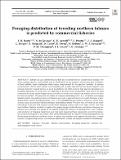Files in this item
Foraging distribution of breeding northern fulmars is predicted by commercial fisheries
Item metadata
| dc.contributor.author | Darby, J. H. | |
| dc.contributor.author | de Grissac, S. | |
| dc.contributor.author | Arneill, G. E. | |
| dc.contributor.author | Pirotta, E. | |
| dc.contributor.author | Waggitt, J. J. | |
| dc.contributor.author | Borger, L. | |
| dc.contributor.author | Shepard, E. | |
| dc.contributor.author | Cabot, D. | |
| dc.contributor.author | Owen, E. | |
| dc.contributor.author | Bolton, M. | |
| dc.contributor.author | Edwards, E. W. J. | |
| dc.contributor.author | Thompson, P. M. | |
| dc.contributor.author | Quinn, J. L. | |
| dc.contributor.author | Jessopp, M. | |
| dc.date.accessioned | 2022-01-18T16:30:24Z | |
| dc.date.available | 2022-01-18T16:30:24Z | |
| dc.date.issued | 2021-11-25 | |
| dc.identifier | 277508383 | |
| dc.identifier | 200c317e-7d49-4922-b29f-5d4012715ae3 | |
| dc.identifier | 000728098900013 | |
| dc.identifier | 85127526852 | |
| dc.identifier.citation | Darby , J H , de Grissac , S , Arneill , G E , Pirotta , E , Waggitt , J J , Borger , L , Shepard , E , Cabot , D , Owen , E , Bolton , M , Edwards , E W J , Thompson , P M , Quinn , J L & Jessopp , M 2021 , ' Foraging distribution of breeding northern fulmars is predicted by commercial fisheries ' , Marine Ecology Progress Series , vol. 679 , pp. 181-194 . https://doi.org/10.3354/meps13887 | en |
| dc.identifier.issn | 0171-8630 | |
| dc.identifier.other | ORCID: /0000-0003-3541-3676/work/106838538 | |
| dc.identifier.uri | https://hdl.handle.net/10023/24701 | |
| dc.description | Funding: J.H.D. was funded by the Irish Research Council Enterprise Partnership Scheme, supported by the Petroleum Infrastructure Program. Field work on Little Saltee in 2018 and 2019 and S.d.G. were funded by the BlueFish project, funded by the European Regional Development fund through the Ireland Wales Cooperation Programme 2014−2020. Fieldwork on Eynhallow and St. Kilda was supported by Orkney Islands Council, the University of Aberdeen, the National Trust for Scotland and Talisman Energy (UK) Ltd. E.W.J.E. was funded by a Marine Alliance for Science and Technology for Scotland and University of Aberdeen studentship. Fieldwork elsewhere was funded by the EU Atlantic area INTERREG program via the Future of the Atlantic Marine Environment (FAME) project and by the RSPB, JNCC, Fair Isle Bird Observatory Trust and Marine Scotland, through the Seabird Tracking And Research (STAR) project. G.E.A. was funded by the MarPAMM project supported by the EU INTERREG VA Programme, managed by the Special EU Programmes Body (SEUPB). | en |
| dc.description.abstract | Habitat-use and distribution models are essential tools of conservation biology. For wide-ranging species, such models may be challenged by the expanse, remoteness and variability of their habitat, these challenges often being compounded by the species' mobility. In marine environments, direct observations and sampling are usually impractical over broad regions, and instead remotely sensed proxies of prey availability are often used to link species abundance or foraging behaviour to areas that are expected to provide food consistently. One source of food consumed by many marine top predators is fisheries waste, but habitat-use models rarely account for this interaction. We assessed the utility of commercial fishing effort as a covariate in foraging habitat models for northern fulmars Fulmarus glacialis, a species known to exploit fisheries waste, during their summer breeding season. First, we investigated the prevalence of fulmar-vessel interactions using concurrently tracked fulmars and fishing vessels. We infer that over half of our study individuals associate with fishing vessels while foraging, mostly with trawl-type vessels. We then used hidden Markov models to explain the spatio-temporal distribution of putative foraging behaviour as a function of a range of covariates. Persistent commercial fishing effort was a significant predictor of foraging behaviour, and was more important than commonly used environmental covariates retained in the model. This study demonstrates the effect of commercial fisheries on the foraging distribution and behaviour of a marine top predator, and supports the idea that, in some systems, incorporating human activities into distribution studies can improve model fit substantially. | |
| dc.format.extent | 14 | |
| dc.format.extent | 2934723 | |
| dc.language.iso | eng | |
| dc.relation.ispartof | Marine Ecology Progress Series | en |
| dc.subject | Fisheries | en |
| dc.subject | Discards | en |
| dc.subject | Marine conservation | en |
| dc.subject | Foraging behaviour | en |
| dc.subject | Habitat use | en |
| dc.subject | Anthropogenic food source | en |
| dc.subject | GC Oceanography | en |
| dc.subject | SH Aquaculture. Fisheries. Angling | en |
| dc.subject | E-NDAS | en |
| dc.subject | SDG 14 - Life Below Water | en |
| dc.subject.lcc | GC | en |
| dc.subject.lcc | SH | en |
| dc.title | Foraging distribution of breeding northern fulmars is predicted by commercial fisheries | en |
| dc.type | Journal article | en |
| dc.contributor.institution | University of St Andrews. School of Biology | en |
| dc.contributor.institution | University of St Andrews. Centre for Research into Ecological & Environmental Modelling | en |
| dc.identifier.doi | 10.3354/meps13887 | |
| dc.description.status | Peer reviewed | en |
This item appears in the following Collection(s)
Items in the St Andrews Research Repository are protected by copyright, with all rights reserved, unless otherwise indicated.

